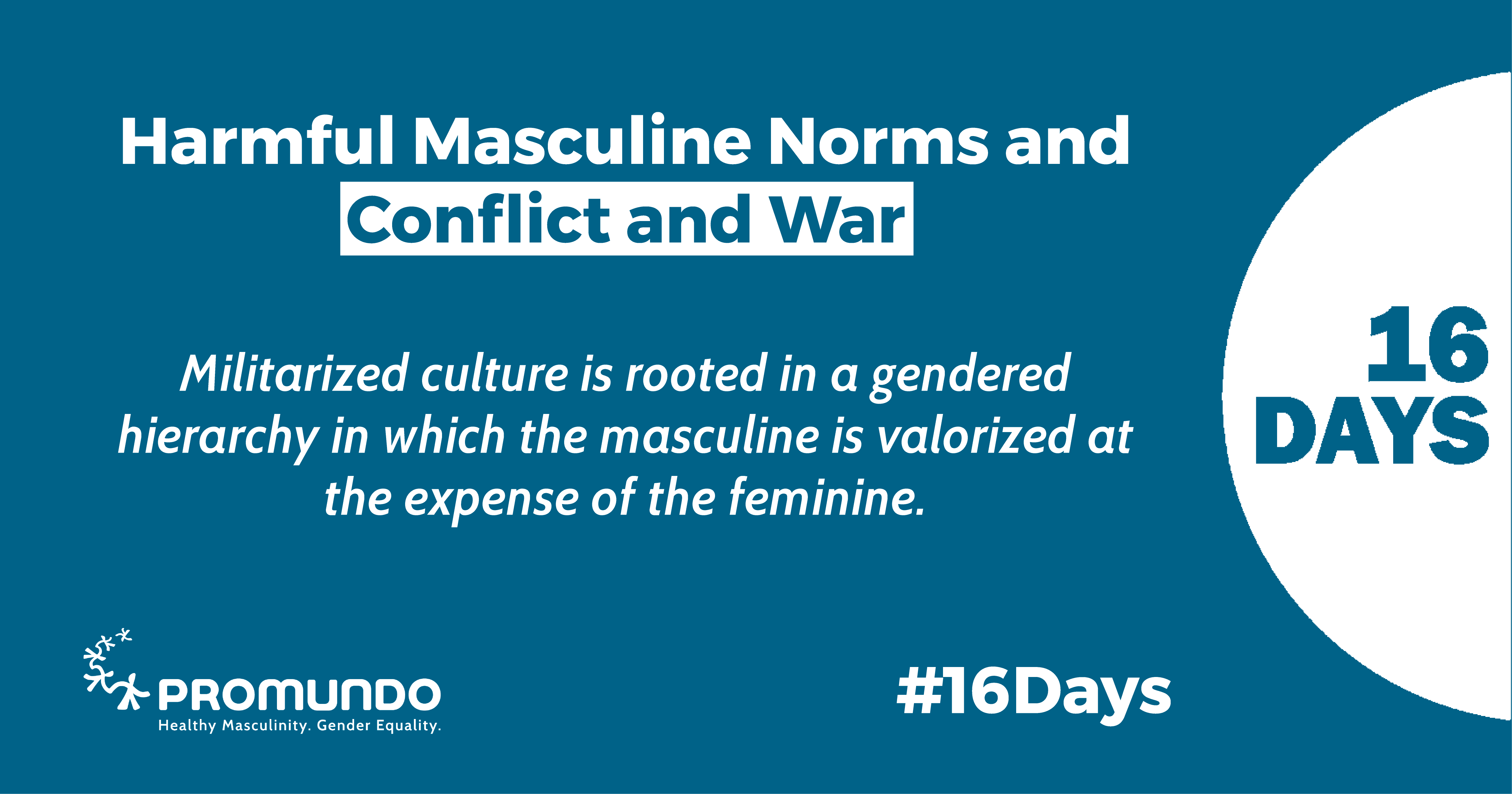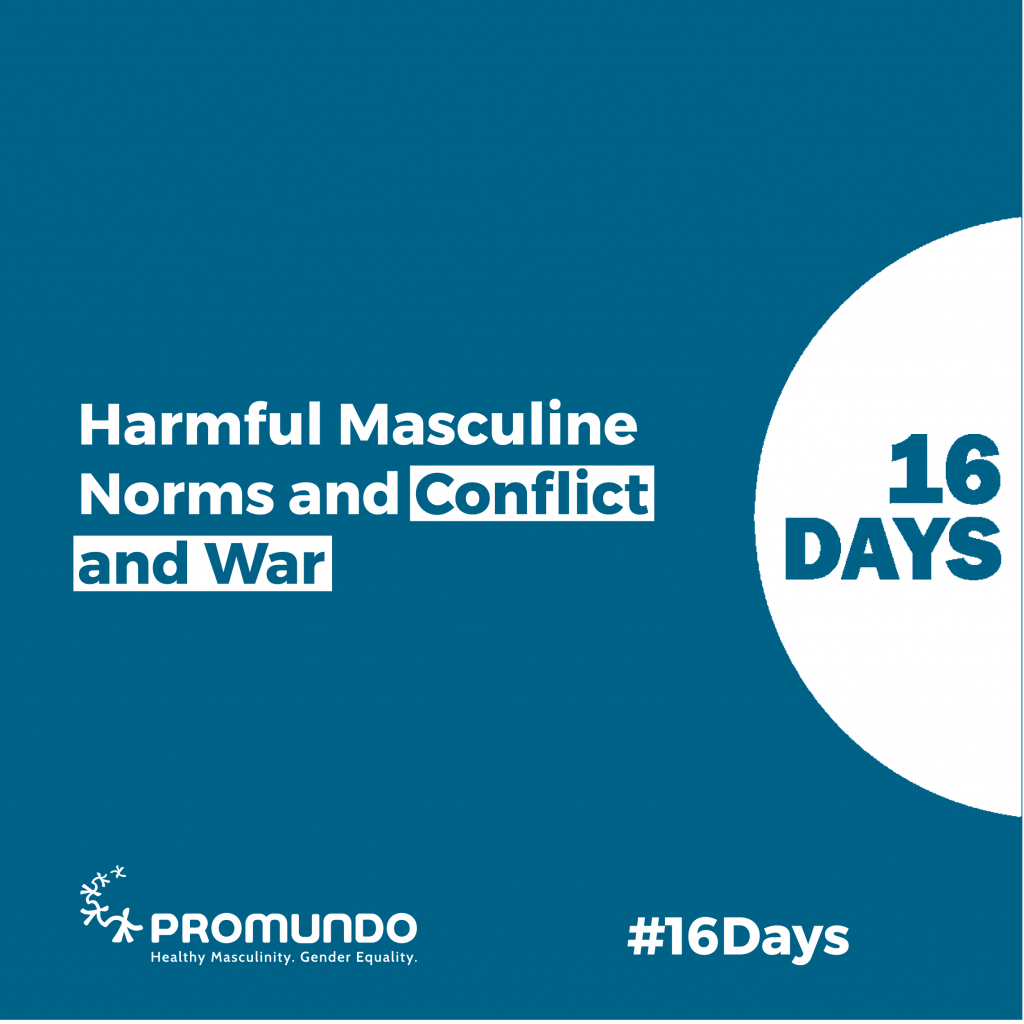Los 16 Días de activismo contra la violencia de género es una campaña internacional utilizada por activistas de todo el mundo (del 25 de noviembre al 10 de diciembre) como estrategia organizativa para pedir la eliminación de todas las formas de violencia de género.
Este año, compartiremos nuestra investigación sobre los vínculos entre las normas masculinas dañinas y ocho formas diferentes de comportamiento violento, así como conocimientos y recomendaciones para eliminar todas las formas de violencia.

Si bien no hay nada inherente al hecho de ser hombre que impulse la violencia, la forma en que socializamos a los niños en sus identidades como hombres y lo que esperamos de ellos (es decir, las normas masculinas de la sociedad) están innegablemente vinculados con la violencia.
De hecho, a menudo se cría, socializa y anima a los niños y a los hombres a usar la violencia de alguna forma; en general, los hombres y los niños tienen una probabilidad desproporcionada de perpetrar la mayoría de las formas de violencia y de morir por homicidio y suicidio. Sin embargo, la investigación afirma que esta violencia es prevenible, la igualdad de género es alcanzable y las normas e ideas no violentas sobre la masculinidad son prevalentes y poderosas.
Informe de la Fundación Equimundo y Oak Normas masculinas y violencia: estableciendo conexiones, examina los vínculos entre las normas masculinas nocivas y ocho formas de comportamiento violento. Este octavo y último blog de la... Estableciendo las conexiones16 días de activismo La serie se centra en los conflictos y la guerra. Analiza los hechos sobre ellos, explora sus vínculos con otras formas de violencia y ofrece recomendaciones para la acción.
Conflicto y guerra
Los hechos
Los hombres tienen una probabilidad desproporcionada de morir como resultado directo de un conflicto armado en comparación con las mujeres. Sin embargo, estas muertes violentas no son las únicas, ni siquiera una proporción importante, de las muertes asociadas con el conflicto activo, y algunos datos sugieren que la mayoría de las muertes totales asociadas con el conflicto activo, considerando las consecuencias indirectas, son de mujeres y niños.
La participación en ejércitos o milicias también es innegablemente masculina. Incluso entre los hombres que se alistan voluntariamente en el ejército o se unen a una milicia o grupo rebelde, existe cierta coerción arraigada en el potencial acceso a una masculinidad dominante, poderosa y privilegiada.
Los enlaces
Algunos investigadores sugieren que la exclusión social de los jóvenes, más que su naturaleza inherente o su número, puede llevarlos a comportamientos violentos.
La violencia, el conflicto y la guerra no se relacionan únicamente con los hombres ni con las masculinidades. Además, estos roles no deben confundirse con los estáticos. Por el contrario, la evidencia indica que las mujeres asumen roles masculinos durante la guerra, incluyendo la participación en combates.
La cultura militar/militarizada se arraiga en una jerarquía de género donde se valora lo masculino por encima de lo femenino. La militarización tradicional se basa en la agresión y la osadía vinculadas a las representaciones de la masculinidad hegemónica, equiparando "ser hombre" con la conquista, la defensa y la disposición a matar. De esta manera, la militarización y la construcción social de masculinidades violentas son procesos que se refuerzan e interdependen.
La cosificación, la deshumanización (incluida la feminización de los combatientes enemigos) y la alterización son fundamentales para la creación de soldados masculinos dispuestos a matar, y las normas masculinas han demostrado ser vehículos útiles para lograrlo. La colonización y la dominación de otras culturas, así como el imperialismo, se consideran justificados e incluso necesarios por las culturas que crean identidades jerárquicas donde el hombre hegemónico está en la cima, posicionando a las identidades masculinas no hegemónicas como inferiores y necesitadas de control.
La represión de la empatía o las conexiones sociales también es un objetivo compartido de la militarización y la masculinidad hegemónica. Las investigaciones también demuestran que la violación en situaciones de conflicto es resultado de una producción específica de masculinidad que se fomenta precisamente por su utilidad para la dominación política.
Las intersecciones
Muchos factores contribuyen a la participación de los hombres en conflictos violentos, como factores estructurales, contextuales, individuales y psicosociales. Estos incluyen la frustración económica (basada en la expectativa social de que los hombres sean proveedores financieros), la exposición temprana a la violencia, el adoctrinamiento traumático y las numerosas maneras en que se glorifica a los militares en un contexto determinado.
La falta de empleo y de movilidad social puede hacer que los jóvenes se unan a conflictos armados como medio para obtener riqueza, como rebelión contra las clases dominantes o como resultado de la vulnerabilidad social.
De la teoría a la práctica
Aún es poco común que las operaciones de mantenimiento de la paz y humanitarias incorporen la concienciación sobre cuestiones de género, y mucho menos enfoques transformadores de género. Las iniciativas destinadas a prevenir conflictos y guerras deberían centrarse en las siguientes transformaciones de las normas masculinas nocivas:
- Brindar a los jóvenes varones oportunidades de vida no violentas y caminos hacia el reconocimiento social.
- Discutir, modelar y fomentar formas no violentas de masculinidad que valoren la expresión emocional, la construcción de comunidad y la humanización del “otro”.
- Involucrar a hombres y niños –y a mujeres y niñas e individuos de todas las identidades de género– en debates sobre las normas tradicionales de género, la violencia y el ejército como un espacio de género.
Lea el resto del Estableciendo las conexionesSerie de blogs de 16 días de activismo para aprender más sobre violencia de pareja; violencia física contra los niños; abuso y explotación sexual infantil; acoso escolar; homicidios y delitos violentos; violencia sexual fuera de la pareja; y suicidio.
